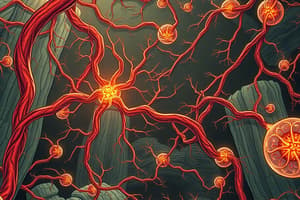Podcast
Questions and Answers
What factors contribute to the successful culture of microspores?
What factors contribute to the successful culture of microspores?
- Physiological maturity of floral buds, chemical composition of the medium, and nutrient supply (correct)
- Temperature, light intensity, and pH of the environment
- Seed germination, root formation, and stress tolerance
- Presence of female chromosomes, genetic information, and organogenesis
Which stage comes after the heart-shaped stage during embryo development?
Which stage comes after the heart-shaped stage during embryo development?
- Torpedo-shaped stage (correct)
- Cotyledonary stage
- Proliferative phase
- Globular stage
How do in vitro conditions affect androgenesis success?
How do in vitro conditions affect androgenesis success?
- By providing an optimal environment for plant development (correct)
- By promoting seed germination
- By increasing stress tolerance in plants
- By reducing male chromosome expression
What is the role of male chromosomes in androgenesis?
What is the role of male chromosomes in androgenesis?
What is essential for successful embryo development during androgenesis?
What is essential for successful embryo development during androgenesis?
Which factor is crucial for plant regeneration techniques according to the text?
Which factor is crucial for plant regeneration techniques according to the text?
In androgenesis, what is the initial cell from which plant regeneration occurs?
In androgenesis, what is the initial cell from which plant regeneration occurs?
What is the purpose of culturing microspores (pollen grains) in androgenesis?
What is the purpose of culturing microspores (pollen grains) in androgenesis?
What is the genetic makeup of plants regenerated through androgenesis?
What is the genetic makeup of plants regenerated through androgenesis?
Which chromosomes are involved in the androgenetic process?
Which chromosomes are involved in the androgenetic process?
What is the primary purpose of using in vitro techniques in androgenesis?
What is the primary purpose of using in vitro techniques in androgenesis?
What is the primary advantage of using androgenesis in agricultural practices?
What is the primary advantage of using androgenesis in agricultural practices?
Study Notes
Androgenesis: A Closer Look into Plant Regeneration, Cultural Microspores, Embryo Development, Male Chromosomes, and In Vitro Conditions
Androgenesis, a form of sexual reproduction, involves the development of male gametes. This mode of reproduction occurs naturally in plants, but artificial inducement through in vitro techniques has been employed in agricultural practices to produce clones of desirable traits. Here, we delve into the intricacies of androgenesis, exploring plant regeneration, cultural microspores, embryo development, male chromosomes, and in vitro conditions.
Plant Regeneration via Androgenesis
Plant regeneration through androgenesis involves the development of a plant from a pollen grain. Unlike traditional seed germination, which starts with a fertilized ovule, androgenesis initiates with a single cell: the pollen grain. By providing suitable environmental conditions, researchers have successfully induced androgenetic plant regeneration in various species, leading to the production of true-to-type, genetically identical individuals.
Cultural Microspores: Pollen Grains Ready for Induction
Cultural microspores are isolated pollen grains that are cultured, often using agar media, to encourage the initiation of androgenesis. The successful culture of microspores depends on various factors, including the physiological maturity of the floral buds from which the pollen was collected, the chemical composition of the medium, and the nutrient supply within the medium. Under optimal conditions, the cultured microspores develop into embryonic structures, eventually forming complete androgynous shoots capable of root formation and further growth.
Embryo Development: From Single Cell to Complete Shoot
Embryogenesis is a complex series of morphological changes that occur after the initiation of androgenesis. Once the microspore has divided, it enters into a proliferative phase, followed by the formation of a globular stage, heart-shaped stage, torpedo-shaped stage, and finally, the cotyledonary stage. During this period, the embryo undergoes massive expansion, organogenesis, and vascularization before reaching the mature shoot stage. Successful embryo development relies heavily on the quality of the initial microspore culture and the subsequent inductive treatments applied throughout the entire process.
Male Chromosomes: Unique Characteristics and Roles
Male chromosomes play a crucial role in the androgenetic process. They are responsible for determining the sex of the plant and carry genetic information that influences the expression of a wide range of traits. For instance, the presence of genes encoding for disease resistance, high yield, stress tolerance, or other economically important characteristics can greatly enhance the value of androgenetic plantlets derived from them. Understanding the unique characteristics and roles of male chromosomes is essential for optimizing androgenesis and producing superior clones.
In Vitro Conditions: Controlling the Environment for Successful Androgenesis
The success of androgenesis largely depends on the in vitro conditions provided. Key factors include the medium composition, nutrient supply, pH, temperature, and light intensity. By carefully manipulating these variables, researchers can create an optimal environment that promotes the initiation, development, and maturation of androgenetic plants. In vitro techniques have allowed for significant advances in the production of androgenetic plants, enabling researchers to overcome the limitations of traditional seed germination and propagation methods.
In conclusion, androgenesis is a fascinating process that has unlocked new possibilities for plant regeneration and cloning. By understanding the intricacies of plant regeneration, cultural microspores, embryo development, male chromosomes, and in vitro conditions, researchers can continue to advance androgenesis techniques, ultimately leading to the production of superior, genetically identical plants for agriculture and other applications.
Studying That Suits You
Use AI to generate personalized quizzes and flashcards to suit your learning preferences.
Description
Dive into the world of androgenesis, a form of sexual reproduction in plants involving male gametes. Explore topics such as plant regeneration, cultural microspores, embryo development, male chromosomes, and in vitro conditions used to induce and manipulate this process.



